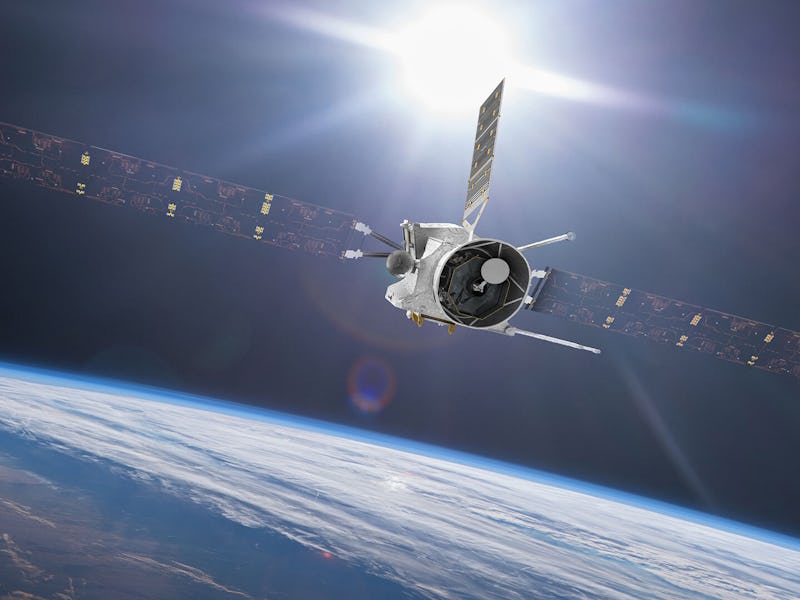This is what aliens would hear if they flew by Earth
Our planet's sounds will likely put them in a very chill mood.

Earth just dropped its latest mixtape, and it is straight fire.
On April 10, spacecraft BepiColombo conducted its first, and only, close flyby of Earth before heading off into the depths of space on its way to the mission's destination, Mercury.
The encounter was brief but memorable, and the spacecraft commemorated this final goodbye with a sweet, ambient lullaby.
BepiColombo captured the sound of Earth's flyby in five recordings, and the eight hours of data were sonified (when abstract data is turned into sound) into a minute's worth of what sounds like a new genre of cosmic indie music.
The original sound is inaudible to humans. Since space is essentially a vacuum, sound waves don't travel there the same way they do down on Earth through wind. However, a team from Italy’s National Institute for Astrophysics (INAF) enhanced the dataset and converted BepiColombo's measurements of the flyby into sound waves.
And the resulting track transports listeners to an underground party in a seedy Brooklyn warehouse where the vibe is both chill and highly tense.
BepiColombo obtained the data in the recording during its close approach to Earth, at a distance of 256, 393 kilometers to 129,488 kilometers, through two of its instruments.
The data obtained by the Italian Spring Accelerometer (ISA) instrument captures the 34 minute flyby of Earth, as the spacecraft sneaks behind the shadow of Earth, away from the light of the Sun. The audio starts with BepiColombo entering its eclipse, and exiting from beyond the Earth's surface.
“When the spacecraft enters the shadow and the force of the Sun disappears, we can hear a slight vibration,” Carmelo Magnafico, one of the team members at ISA, said in a statement. “The solar panels, previously flexed by the Sun, then find a new balance. Upon exiting the shadow, we can hear the effect again."
A second dataset was obtained by BepiColombo's MPO-MAG instrument as it flew through Earth's magnetosphere, or the area around the planet that is affected by its magnetic field.
As explained in the video, the track starts off with BepiColombo at the so-called bow shock on the outer edge of the magnetosphere, an area where Earth’s magnetic field interacts with the solar wind.
The spacecraft then passed through the magnetosheath, a turbulent region being hit by the cosmic plasma flaring out from the Sun, before crossing the magnetopause, the boundary that signals crossing into the area dominated by Earth's magnetic field.
This track sounds a bit wonky, and a little more on the experimental side. Earth's magnetic field is less harsh ambient music, and more strobe-lit, impromptu rager at your DJ friend's house. The two sounds together call to mind some of the albums listed recently on Pitchfork's Top 50 Ambient Albums of All Time. The first, a harsher sound with only a noticable "plonk" at the end, calls to mind some of the earlier works of Daniel Lopatin, also known as Oneohthrix Point Zero.
The sounds of the magnetosphere are, by comparison, filled with sonic wonder, twisting constantly like TV static caught in the wind. They call to mind the out-there and groundbreaking music of Suzanne Ciani.
Other spacecraft have recorded the sounds of their host planets before, and the results have always been equally trippy and satisfying. In 2016, NASA's Juno mission recorded its encounter with Jupiter's magnetic field, and it sounded like a violent uproar of a windy world.
In 2005, the Cassini mission recorded the sounds of Saturn, and the results had us wishing we had never pressed play. The audio sounded like the inside of a haunted house, and gave this ringed planet an eerie vibe that's hard to erase from memory.
Aside from providing us with these trippy space sounds, the recordings also help the team behind missions like BepiColombo calibrate the instruments and better prepare them for future data collection.
BepiColombo launched in October 2018 to explore the Solar System's innermost planet, Mercury.
BepiColombo is designed to transform our knowledge of Mercury by studying the planet's surface in order to identify its composition and geological history, as well as measure its magnetic conditions.
The Earth flyby allowed ESA’s ground control team to do one final check of the spacecraft’s instruments and sensors before sending it on its way. BepiColombo also used Earth as a gravity assist, slowing down from 30.4 to 25 kilometers a second to put itself on a better path to fall into orbit around Mercury.
It is expected to reach Mercury by the year 2025.